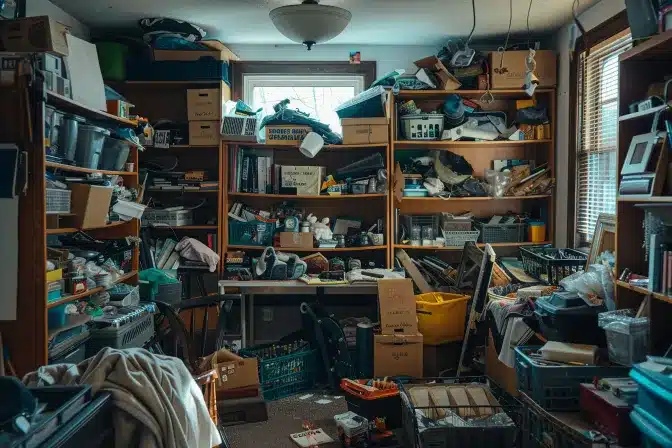If you’re tackling cleaning with ADHD, start by setting clear goals and gathering supplies to stay on track. Begin with small areas, declutter surfaces, and sort items with micro cleaning techniques. Utilize organizational tools, time management, and mindful cleaning to enhance focus. Remember to take breaks, celebrate progress, and appreciate your achievements. Discover more ways to optimize your ADHD cleaning checklist for efficiency and success.
Setting Clear Goals
When creating a cleaning checklist for managing ADHD, make sure to set clear and achievable goals. Goal visualization is key – envision the outcome you desire to stay motivated. Time blocking can help break down tasks into manageable chunks, making it easier to focus and avoid feeling overwhelmed. By setting specific time frames for each task, you can create a structured plan to follow.
Having accountability buddies can provide the support and encouragement needed to stay on track. Share your goals with someone you trust and ask them to check in on your progress regularly. This external accountability can help you stay committed and motivated to complete your cleaning tasks.
Implementing a self-reward system can also be beneficial. After completing each task or reaching a milestone, treat yourself to something you enjoy. This positive reinforcement can help reinforce good habits and make the cleaning process more enjoyable.
Gathering Supplies
To efficiently prepare for your cleaning tasks, ensure you have all the necessary supplies gathered and organized beforehand. Here are some key steps to help you get started:
- Cleaning product selection: Choose cleaning products that are effective but also safe for the environment and your health. Consider using multi-purpose cleaners to simplify your cleaning routine.
- Organizing storage spaces: Keep your cleaning supplies in an easily accessible and well-organized manner. This will save you time and prevent distractions while cleaning.
- Creating cleaning schedule: Develop a cleaning schedule that breaks down tasks into smaller, manageable chunks. This will help you stay focused and avoid feeling overwhelmed.
- Implementing reward system: Set up a reward system for yourself to celebrate small accomplishments. This can motivate you to stay on track and complete your cleaning tasks efficiently.
Starting Small Areas
Begin tackling your cleaning tasks by focusing on small areas to prevent feeling overwhelmed. Utilize micro cleaning techniques and small space solutions to make the process more manageable. Start with quick wins to build momentum and keep yourself motivated. Cleaning hacks like setting a timer for 10 minutes and focusing on decluttering a small corner or drawer can be incredibly effective.
Consider using the ‘5-Minute Rule‘ where you commit to cleaning for just 5 minutes in a specific area. This approach tricks your brain into thinking it’s a small, manageable task, making it easier to get started.
Another strategy is to break down larger tasks into smaller, more achievable steps. For example, instead of trying to clean the entire kitchen, start with wiping down the countertops.
Decluttering Surfaces
You need to focus on clearing off tables, tidying up counters, and organizing shelves.
By decluttering these surfaces, you can create a more organized and visually appealing space.
Start by removing any unnecessary items and finding designated spots for the essentials.
Clearing off Tables
Clear off tables by removing any unnecessary items to create a clean and organized surface. When decluttering tables, focus on surface organization and space optimization.
Here are some quick steps to help you efficiently clear off tables:
- Sort through items, keeping only those you use daily.
- Allocate a designated spot for each item to avoid clutter.
- Use organizers like trays or baskets to group similar items together.
- Regularly declutter to maintain a tidy tabletop.
Tidying up Counters
To maintain an organized space, focus on tidying up counters by decluttering surfaces effectively. Start by clearing off any unnecessary items to optimize counter organization. Keep only essential items like kitchen appliances or frequently used utensils to ensure efficient space utilization.
Avoid overcrowding your counters with decorative pieces or excessive clutter. Create designated areas for different items to streamline your workflow and reduce visual distractions. Implement storage solutions such as baskets or shelving units to maximize vertical space and keep countertops clear.
Regularly assess your counters and remove any items that don’t serve a specific purpose. By following these simple steps, you can maintain a tidy and organized environment that supports productivity and focus.
Organizing Shelves
When organizing shelves to declutter surfaces effectively, prioritize grouping similar items together for streamlined accessibility. To maximize space and make the most of your shelves, consider the following tips:
- Use vertical space: Stack items where possible to free up horizontal space.
- Utilize clear containers: Opt for transparent containers to easily see what’s inside and label them for quick identification.
- Arrange frequently used items at eye level: Keep items you use often within easy reach for convenience.
- Rotate seasonal items: Store seasonal items in labeled containers and swap them out to keep your shelves organized and clutter-free.
Sorting Items
Begin by categorizing items based on their type and purpose to streamline the cleaning process. Categorizing belongings makes for efficient sorting and quick cleanup. Separate items into distinct groups such as clothing, books, electronics, and miscellaneous items. This method helps you focus on one category at a time, preventing overwhelm and making it easier to decide where each item belongs.
When organizing by type, consider the purpose of each item. For example, place all kitchen utensils together, group electronic devices in one area, and keep all paperwork in a designated spot. This approach not only makes it simpler to find things later but also speeds up the cleaning process. Remember, the goal is to create a system that works for you and helps maintain order in your space.
Time Management Techniques
Efficiently managing your time is essential for maintaining productivity and organization in your daily routine. To improve your time management skills, consider the following techniques:
- Time Tracking: Start by tracking how you currently spend your time. Use tools like timers or apps to monitor the time spent on different activities throughout the day.
- Prioritizing Tasks: Identify the most important tasks that need to be accomplished. Focus on completing these tasks first before moving on to less critical ones.
- Setting Clear Goals: Establish specific and achievable goals for each day. Having a clear roadmap of what needs to be done can help you stay on track.
- Creating a Schedule: Develop a daily or weekly schedule outlining when you’ll work on specific tasks. Allocate time blocks for different activities to ensure everything gets done efficiently.
Utilizing Organizational Tools
Consider incorporating organizational tools into your daily routine to enhance efficiency and structure. Digital organization can be a game-changer for individuals managing ADHD. Utilize apps or software that allow you to create to-do lists, set reminders, and organize tasks based on priority. By having a digital platform to manage your tasks, you can easily access and update your lists on the go, ensuring nothing slips through the cracks.
Task prioritization is another key aspect of utilizing organizational tools effectively. With ADHD, it’s common to feel overwhelmed by the number of tasks at hand. Organize your tasks based on urgency and importance. This can help you focus on what needs to be done first and prevent you from getting lost in a sea of responsibilities. Consider using tools like task managers that allow you to categorize tasks according to their priority level, making it easier to tackle them in a structured manner.
Mindful Cleaning
Focus on the task at hand and stay mentally present as you tackle your cleaning chores. By being mindful, you can enhance your focus and productivity, making the process more efficient and enjoyable.
Remember to breathe and appreciate the progress you’re making as you engage in mindful cleaning.
Focus on Task
To enhance your cleaning experience, try staying fully present in the moment while engaging in each task. This mindful approach can help you improve your focus, productivity, task completion, and time management. Here are some tips to help you stay on track:
- Prioritize tasks based on importance and urgency.
- Break down cleaning activities into smaller, manageable steps.
- Set specific goals for each task to maintain focus.
- Use timers or alarms to stay on schedule and avoid getting sidetracked.
Stay Present Mentally
Enhance your cleaning experience by immersing yourself fully in the present moment, practicing mindful cleaning techniques to boost your focus and efficiency. Start by incorporating mindful breathing into your routine. Take deep breaths in and out as you clean, allowing yourself to stay centered and focused on the task at hand.
Additionally, utilize visualization techniques to envision the end goal of your cleaning session. Picture the organized and clutter-free space you’re working towards, which can motivate you to stay present and engaged.
Taking Breaks
Incorporate short breaks strategically throughout your cleaning routine to maintain energy levels and productivity. It’s essential to take care of yourself while tackling tasks, especially if you have ADHD. Break strategies and productivity tips can help you stay focused and efficient.
Here are some ideas to make the most of your breaks:
- Stretch and Move: Engage in quick stretches or a short walk to re-energize your body and mind.
- Hydrate: Drink a glass of water to stay hydrated and refreshed during your cleaning session.
- Deep Breathing: Practice deep breathing exercises to reduce stress and increase concentration.
- Mindful Moments: Take a moment to appreciate your progress and refocus your attention before getting back to work.
These relaxation techniques not only boost productivity but also offer mental health benefits. By incorporating these simple breaks into your cleaning routine, you can optimize your efficiency and well-being.
Celebrating Progress
As you navigate through your cleaning checklist, remember to acknowledge the small wins and find joy in your accomplishments.
Celebrating progress, no matter how minor, can boost your motivation and morale.
Embrace each step forward as a victory worth celebrating.
Acknowledging Small Wins
Celebrate every small accomplishment along the way to keep yourself motivated and positive. Recognizing achievements and building confidence are crucial steps in your journey. Here are some ways to acknowledge those small wins:
- Give yourself a high-five or a fist pump when you complete a task.
- Write down your achievements in a journal to track your progress.
- Treat yourself to something you enjoy after reaching a cleaning milestone.
- Share your successes with a supportive friend or family member for extra encouragement.
Finding Joy in Accomplishments
When you take a moment to revel in your progress, you infuse your journey with a sense of joy and satisfaction. Finding fulfillment in the steps you’ve taken can be a powerful motivator in your ADHD cleaning checklist.
Embracing achievements, no matter how small, can boost your confidence and keep you moving forward. Celebrating progress allows you to recognize the effort you’ve put in and the results you’ve achieved, creating a positive cycle of productivity.
Frequently Asked Questions
How Can I Involve My Family Members or Roommates in the Cleaning Process if They Are Not as Organized or Motivated?
To involve family or roommates in cleaning, motivate and organize them. Share responsibilities and encourage teamwork. Set clear tasks, offer positive reinforcement, and create a routine together. Make it fun by playing music or setting small rewards for completing tasks.
What Are Some Tips for Maintaining a Clean and Organized Space Once It Has Been Decluttered and Cleaned?
To maintain a clean space after decluttering, focus on time management. Set aside small chunks of time daily for tidying up. Use maintenance strategies like putting items back after use, doing quick clean-ups, and involving others to create a shared responsibility.
How Can I Address the Emotional Aspect of Decluttering and Letting Go of Items That Hold Sentimental Value?
When addressing the emotional aspect of decluttering, imagine a cozy space free of clutter. Acknowledge emotional attachments, but remember that letting go of items can bring peace. Reflect on the sentimental value, and gradually release what no longer serves you.
Are There Any Specific Strategies for Tackling Cleaning and Organizing Tasks in Shared Living Spaces, Such as a Dorm Room or Apartment?
When tackling cleaning and organizing in shared spaces, prioritize tasks based on importance. Manage time effectively by setting a schedule. Multitask by combining simple chores. Delegate responsibilities to roommates for efficient teamwork. Communication is key to maintaining a tidy dorm or apartment.
How Can I Prevent Myself From Becoming Overwhelmed or Discouraged When Faced With a Large Cleaning or Decluttering Project?
When facing a big cleaning task, remember to breathe and stay present. Break it into smaller chunks, focusing on one area at a time. Use time wisely by prioritizing tasks. Manage stress with mindfulness techniques.






